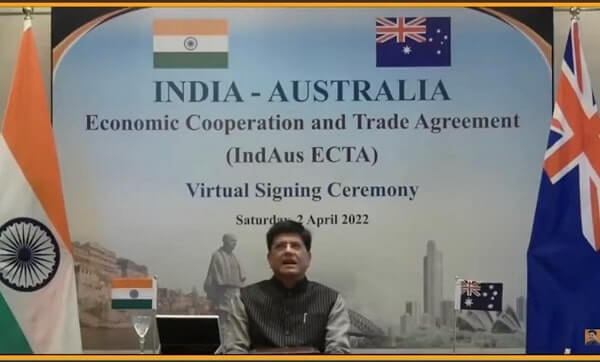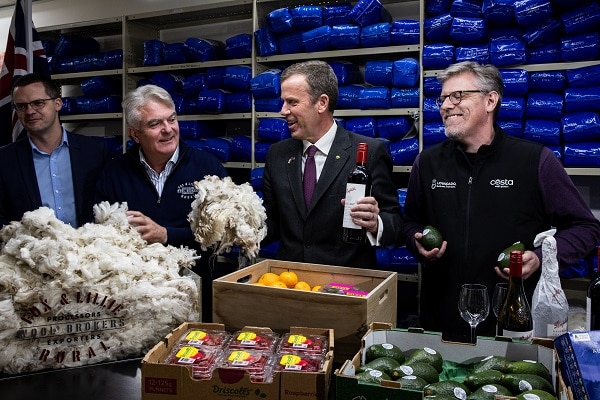Australia and India have finally broken their ten-year jinx of negotiating a bilateral trade agreement.
On 2 April, as many parts of India marked Gudi Padwa, the traditional new year festival, the two nations signed off on an interim trade agreement, called India Australia Economic Cooperation and Trade Agreement (IndAus ECTA), with the commitment to a Comprehensive Economic Partnership Agreement (CEPA) by the end of this year.
The deal is a categorical reflection of Australia’s ambition to build an engaging economic relationship with the world’s fastest growing economy, and nurture a new understanding of the opportunities that India offers. China is no longer Australia’s best trading ‘friend’, and COVID-19 has spared none. For naysayers, the signing of the trade deal is also a lesson in ‘strategic patience’ and ‘opportune timing’, a statement on the convergence of aspirations for the relationship, and new geo-economic and strategic ambitions.
With federal elections just a few weeks away, PM Morrison has with this deal affirmed his government’s commitment to build Australia’s economic resilience and security by focusing on the need for economic diversification. IndAus ECTA will allow tariffs to be eliminated on more than 85 per cent of Australian goods exports to India (valued at more than $12.6 billion a year), and 96 per cent of Indian goods imports entering Australia. Australia’s goal is to lift India into its top three export markets by 2035, and to make India the third largest destination in Asia for outward Australian investment.
READ ALSO: Why the Australia-India relationship has nowhere to go but up
Past and present
Since the elevation of Australia-India bilateral ties to a Comprehensive Strategic Partnership (CSP) in 2020, the engagement on both sides has amplified across multiple platforms and sectors, clearly focused on building tangible commitments and actions, to embrace a win-win partnership. If 2020 was about CSP, 2021 was about bringing pace and energy, and solidifying the bilateral economic engagement through numerous announcements and engagements. And 2022 is already proving itself to be scripting a new and committed engagement narrative.
There has been a holistic approach to build the Australia-India bilateral story.
At the political level, this is evident in the announcement of annual summits at the level of the Heads of Government, making Australia only the third country with which India will hold such an institutionalised review of relations.
At the economic level, the release of the Updated India Economic Strategy to 2035, which chalks out a post-COVID bilateral economic engagement roadmap, will focus on investment to strengthen linkages with India’s key policy, finance institutions and enhanced business engagement.

At the diaspora level, the release of Australia’s Indian Diaspora report, a national asset description, focuses on a better understanding of the Indian diaspora’s reach into the bilateral economic relationship and integrating the Indian diaspora as compelling changemakers in overall ties. The Diaspora is a living bridge between nations, with a natural advantage of language skills, cultural understanding and transnational networks that can be brought to use in a meaningful way.
Australia’s investment of over $280 million in initiatives will drive deeper economic and cultural ties, including “green steel” partnership, critical minerals, innovation and technology, space investment and a new Centre for Australia-India Relations, along with proactive Ministerial engagements, MoUs and commitment to finding shared values and partnerships that meet mutual needs.
Australia and India have also launched the Australia India Infrastructure Forum, to promote two-way investment in infrastructure and support broader trade and investment bilateral objectives. Both countries have also decided to focus on manufacture and deployment of ultra-low-cost solar and green hydrogen technologies, as part of the low emissions technology partnership. Over 90% of solar cells globally use Australian technology. India in the next 10 years will be one of the largest adopters of solar technology in the world and Australian and Indian innovators have significant potential to work together in this area. The focus is to have a wider economic and strategic growth strategy and access that is inclusive, respects the rule of law be it with the QUAD in specific, the Supply Chain Resilience Initiative or the Indo-Pacific region as a whole.
Overall, the focus has been to keep the Australia story thriving in India, and the India story thriving in Australia on a consistent basis in public memory, involving a holistic multi-stakeholder strategy and approach that deepens understanding and appreciation of each other.
The ‘New Normal’ diplomacy narrative between Australia and India is aware that it must be entrepreneurial, creative, and be led by a nuanced understanding of dynamic factors like consumerism, capability, and capacity.

Reflections
India has set itself a target to achieve 5 per cent share in world merchandise exports and 7 per cent in services exports by 2025. IndAus ECTA will facilitate market-seeking approach of both countries, assist in building brand India and brand Australia in respective markets and develop business confidence. It will bring India to the centre of Corporate Australia’s business aspirations and connect Australian corporates to the New India growth story, along with witnessing tariff reductions on traded goods.
The twin impact of geopolitical tensions and COVID-19 has exposed the weakness of the Australian trading economy. IndAus ECTA is likely to secure new growth opportunities to support long-term security for the Australian economy.
The past 18 months in bilateral ties have been exciting and actioned packed, perhaps more so than ever before. The constant shuttle between gloom and doom of COVID and the ambitions of government to maximise options and opportunities for producers, manufacturers and industry sectors has been an interesting lesson in how tough times can become a lever for new promising gains.
The goal for professional consulting firms (such as Newland Global Group) is of simplifying and strengthening trade and investment ties between Australia and India. The journey may have been arduous, but it has definitely transitioned today from ‘Why India’ to ‘How to in India’ – an educated withdrawal from treating India as an option to engaging with it as an informed choice.
However, it is important to note that in any trade deal, governments can open the door, but it is up to business to find the courage to walk through it and strategise and capitalise on existing opportunities. The governments have delivered. Will business follow?
As renowned business strategist and author Ram Bijapurkar aptly writes in her book We Are Like That Only “India needs to be understood on its own terms. It will always march to its own tune. Let’s ask ourselves the right questions, deal with diversity, design for digital media, ride the youth boom, understand urban markets, understand rural India, learn from countries and companies who got it right, learn from startups and micro-entrepreneurs! It is not just about consumption or how much money people have. It is about their aspirations, pain points and the larger community context. India is where the future will be made. Let’s get it right.”
READ ALSO: Coalition or Labor: Who would be better for India?
Highlights of IndAus ECTA
- Sheep meat tariffs of 30 per cent to be eliminated
- Wool, current 2.5 per cent tariffs to be eliminated
- Tariffs on wine with a minimum import price of US$5 per bottle to be reduced from 150 per cent to 100 per cent, subsequently to 50 per cent over 10 years
- Tariffs on wine bottles with minimum import price of US$15 to be reduced from 150 per cent to 75 per cent, subsequently to 25 per cent over 10 years
- Tariffs up to 30 per cent on avocados, onions, broad, kidney and adzuki beans, cherries, shelled pistachios, macadamias, cashews in-shell, blueberries, raspberries, blackberries, currants will be eliminated over seven years
- Tariffs on almonds, lentils, oranges, mandarins, pears, apricots, strawberries to be reduced, opening opportunities for Australia’s horticulture industry
- Tariff elimination in the resources sector (coal, alumina, metallic ores, including manganese, copper and nickel; critical minerals including titanium and zirconium)
- LNG tariffs will be bound at 0 per cent at entry into force
- Tariffs on pharmaceutical products and certain medical devices to be eliminated over five and seven years
- Exports such as dairy and beef have been excluded from the deal
- Both countries to facilitate the recognition of professional qualifications, licensing, and registration procedures between professional services bodies in both countries
- New access for young people from India to participate in working holidays in Australia, with places set at 1,000 a year
- Indian students with a bachelor’s degree with first-class honours will also be allowed to stay in Australia for three years after their graduation, rather than the current two years from (STEM) & (ICT) sectors
- Both countries are working towards an Agricultural MoU
- Stronger partnership in critical minerals, professional services, education, and tourism
- The “early harvest” agreement will be notified to the World Trade Organisation, indicating it has the legal status of a full free trade deal
Top exports – states advantage
- NSW exports: sheep meat, wine, malt, certain nuts, wool, coal, copper ores and concentrates and certain pharmaceutical products
- Victorian exports: sheep meat, malt, wine, wool, petroleum oils, medicaments, lentils and almonds
- Western Australian exports: wine, barley, and rock lobster
- South Australian exports: sheep meat, wine, lentils, and almonds
- Tasmanian exports: sheep meat, wine, cherries, and wool
- Queensland exports: coal, certain nuts, hides and skin, bauxite, and medicaments
Dipen Rughani is the Founder and CEO, and Natasha Jha Bhaskar General Manager, of Newland Global Group, a Sydney-based Australian corporate advisory firm specializing in the Australia-India space.
READ ALSO: Quad Fellowship: $50k scholarship now open for STEM students




